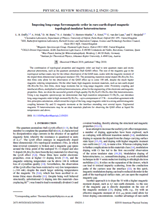
Imposing long-range ferromagnetic order in rare-earth-doped magnetic topological-insulator heterostructures
L.B. Duffy, A. Frisk, D.M. Burn, N.J. Steinke, J. Herrero-Martin, A. Ernst, G. van der Laan and T. Hesjedal
Phys. Rev. Materials 2, 054201 (2018)
DOI: 10.1103/PhysRevMaterials.2.054201
The combination of topological properties and magnetic order can lead to new quantum states and exotic physical phenomena, such as the quantum anomalous Hall (QAH) effect. The size of the magnetic gap in the topological surface states, key for the robust observation of the QAH state, scales with the magnetic moment of the doped three-dimensional topological insulator (TI). The pioneering transition-metal doped (Sb,Bi)2(Se,Te)3 thin films only allow for the observation of the QAH effect up to some 100 mK, despite the much higher magnetic ordering temperatures. On the other hand, high magnetic moment materials, such as rare-earth-doped (Sb,Bi)2(Se,Te)3 thin films, show large moments but no long-range magnetic order. Proximity coupling and interfacial effects, multiplied in artificial heterostructures, allow for the engineering of the electronic and magnetic properties. Here, we show the successful growth of high-quality Dy:Bi2Te3/Cr:Sb2Te3 thin film heterostructures. Using x-ray magnetic spectroscopy we demonstrate that high transition temperature Cr:Sb2Te3 can introduce long-range magnetic order in high-moment Dy:Bi2Te3 —up to a temperature of 17 K— in excellent agreement with first-principles calculations, which reveal the origin of the long-range magnetic order in a strong antiferromagnetic coupling between Dy and Cr magnetic moments at the interface extending over several layers. Engineered magnetic TI heterostructures may be an ideal materials platform for observing the QAH effect at liquid He temperatures and above.